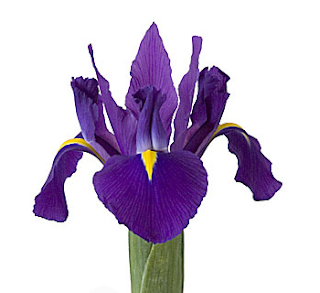Day 96 - Named after Charles Bouvard, the personal physician to Louis XIII and the superintendent of the Royal Gardens in Paris, modern varieties of bouvardia have names such as Pink Luck, Albatross and Royal Katty. Their star-like flowers grow in clusters on thin, branching stems, like small flower bouquets in soft shades of pink, white, yellow, salmon and red. With a delicate scent and feminine appearance, in the language of flowers, bouvardia represent enthusiasm.
Day 97 - With a host of names – from Texas Bluebell to Prairie Gentian to Lira de San Pedro – lisianthus symbolize an outgoing nature. Native to Texas and Mexico, and descended from a North American wildflower, in their single-form variety, lisianthus may resemble tulips or poppies. In their double form, they can take on the appearance of roses or peonies. With wide ruffled, delicate petals and oval leaves, in colors ranging from white to pink, lavender to purple and bicolors such as blue-violet, it’s said that lisianthus also symbolize appreciation.
Day 98 - Legend has it that Queen Anne, the wife of King James I, was challenged by her friends to create lace as beautiful as a flower. While making the lace, she pricked her finger, and it’s said that the purple-red flower in the center of Queen Anne’s Lace represents a droplet of her blood. Also called Wild Carrot (since Queen Anne’s Lace is the wild progenitor of today’s carrot), Bishop’s Lace or Bird’s Nest (for the nest-like appearance of the bright white and rounded flower in full bloom), in the language of flowers, Queen Anne’s Lace represents sanctuary.
Day 99 - Native to Asia and celebrated for its medicinal properties as well as its bright beauty, the small camellia-like ranunculus ranges from white to pink, red to yellow to orange. Also known as Buttercup and Coyote’s Eyes, legend has it that the mythological Coyote was tossing his eyes up in the air and catching them when Eagle snatched them. Unable to see, Coyote created eyes from the buttercup. In the language of flowers, a bouquet of ranunculus says, “I am dazzled by your charms.”
Day 100 - With its richly colored yet small, delicate flowers, the sweet pea’s history can be traced back to 17th century Italy, when a Sicilian monk, Franciscus Cupani, sent its seeds to England. Although that original sweet pea bore little resemblance to the flower we know today, when Harry Eckford, a Scottish nurseryman, crossbred the original flower, he created the colorful, ornamental and sweetly scented sweet pea we know today. Ekford’s varieties included the pink Dorothy Eckford, the lavender Lady Grisel Hamilton, the scarlet King Edward VII and perhaps his most famous, the Countess Spencer. Meaning delicate or blissful pleasure in the language of flowers, this enchanting flower remains a favorite fragrant blossom.













































